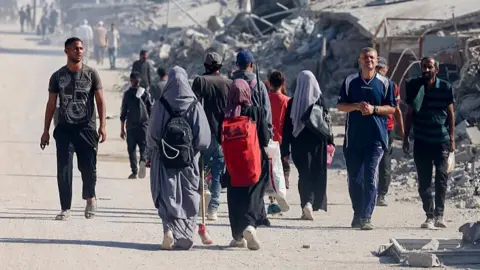Frank GardnerBBC Security Correspondent, Jerusalem and
Paulin Kola
 Getty Images
Getty ImagesIsrael has launched air strikes in southern Gaza, after it said “terrorists fired an anti-tank missile and gunfire toward IDF [Israel Defense Forces] troops”.
The IDF said the attack in the southern city of Rafah was “a blatant violation of the ceasefire agreement” and promised to respond firmly.
Hamas said it was “unaware of any events or clashes taking place in the Rafah area, as these are red zones under the control of the occupation”.
The ceasefire deal – part of President Donald Trump’s plan to end the Gaza war – came into force on 10 October. The first phase currently under way has seen the release of all living hostages as well as the return to Israel of 12 out of 28 of those deceased.
Israel has freed 250 Palestinian prisoners in its jails and 1,718 detainees from Gaza, as well as returning 15 bodies of Palestinians in return for every Israeli hostage’s remains.
The Israeli military launched a campaign in Gaza in response to the 7 October 2023 attack, in which Hamas-led gunmen killed about 1,200 people in southern Israel and took 251 others hostage.
At least 68,000 people have been killed by Israeli attacks in Gaza since then, according to the Hamas-run health ministry, whose figures are seen by the UN as reliable.
In its statement on Sunday, the IDF said “terrorists fired an anti-tank missile and gunfire toward IDF troops operating to dismantle terrorist infrastructure in the Rafah area, in southern Gaza”.
“In response, the IDF has begun striking in the area to eliminate the threat and dismantle tunnel shafts and military structures used for terrorist activity.”
Prime Minister Benjamin Netanyahu’s office said he had met top defence officials and instructed them “to act forcefully against terrorist targets in the Gaza Strip”.
Hamas’s military wing denied knowledge of any clashes in the Rafah area.
In its statement, al-Qassam Brigades said: “Contact with our remaining groups there has been cut off since the resumption of war in March of this year.
“Therefore, we have no connection to any events taking place in those areas, and we cannot communicate with any of our fighters there, if any of them are still alive.”
IDF forces still occupy and control just over 50% of the Gaza Strip, having withdrawn to an agreed so-called yellow line.
Hamas, which has ruled the territory for 18 years, is facing a challenge from armed groups, such as Yasser Abu Shabab’s Popular Forces, gangs which it says are being armed and supported by Israel.
It has recalled about 7,000 members of its security forces to reassert control in Gaza, according to local sources.
A local source familiar with Sunday’s incident told BBC News that Hamas fighters attacked a group affiliated with Abu Shabab in south-eastern Rafah, an area controlled by Israeli forces.
The militants reportedly came under surprise tank fire, leading to a short exchange of gunfire before Israeli warplanes bombed the site.
Residents living south of the nearby European Hospital said the strikes were accompanied by artillery shelling, with explosions shaking parts of Rafah.
Under the Trump 20-point ceasefire, Hamas is supposed to relinquish its weapons so that it no longer poses a threat to Israel.
Hamas has accused Israel of funding and arming rival gangs that it says have looted aid trucks. It says Israel is deliberately empowering criminal gangs so as to challenge Hamas’ authority and foment chaos.
Without the presence of a robust international force in Gaza there is a real risk of further fighting between Palestinian factions.
The attacks in Rafah came hours after the US said it had “credible reports” that Hamas was planning an “imminent” attack on civilians in Gaza, which, it said, would be a “direct and grave” violation of the ceasefire agreement.
A planned attack against Palestinians would “undermine the significant progress achieved through mediation efforts”, the state department said.
The statement did not not provide further details.
Hamas has strongly denied any planned imminent attack.
The state department said it had already informed other guarantors of the Gaza peace agreement – which include Egypt, Qatar and Turkey – and demanded Hamas uphold its end of the ceasefire terms.
“Should Hamas proceed with this attack, measures will be taken to protect the people of Gaza and preserve the integrity of the ceasefire,” the US statement said.
The ceasefire agreement also states that regional partners will ensure that “Hamas, and the factions, comply with their obligations and that New Gaza poses no threat to its neighbours or its people”.
Therefore, any instances or evidence of armed action by either Hamas or other factions in Gaza would be considered a violation of the ceasefire.
Trump has previously warned Hamas against the killing of civilians.
“If Hamas continues to kill people in Gaza, which was not the Deal, we will have no choice but to go in and kill them,” Trump said in a post on Truth Social earlier this week.
He later clarified that he would not be sending US troops into Gaza.
Last week, BBC Verify authenticated graphic videos that showed a public execution carried out by Hamas gunmen in Gaza.
Fierce clashes erupted a week ago involving Hamas security forces and armed members of the Dughmush family in Gaza City.
Twenty-seven people were killed in what was one of the most violent internal confrontations since the end of major Israeli operations in the enclave.



